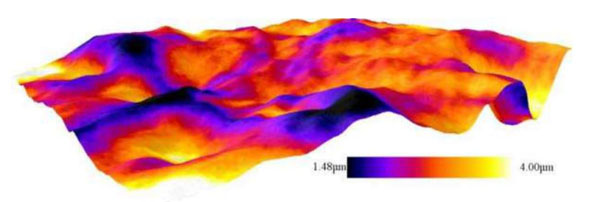X-ray Microtomography Analysis of Ink on Coated Paper
![]() Print this Article | Send to Colleague
Print this Article | Send to Colleague
A new report made available this past week by TechFragments (Singapore) examines a new way to see the ancient art of putting ink to paper in unprecedented 3-D detail. The technology has been developed by team of scientists at the University of Jyvaskyla in Finland. The technique could improve scientists’ understanding of how ink sticks to paper and ultimately lead to higher quality, less expensive, and more environmentally-friendly printed products.
Using modern X-ray and laser-based technologies, the researchers created a nano-scale map of the varying thickness of toner ink on paper. They discovered that wood fibers protruding from the paper received relatively thin coatings of ink.
In general, they also found the toner thickness was dictated mainly by the local changes in roughness, rather than the chemical variations caused by the paper’s uneven glossy finish.
"We believe that this gives new insight, especially on how the topography of paper impacts the ink setting or consolidation. This in turn helps us understand how glossy and non-glossy printed surfaces should be made," said Markko Myllys, an applied physicist at the University of Jyvaskyla.
To achieve their detailed picture of ink thickness, the researchers first examined the underlying paper with X-ray microtomography, a smaller cousin of the CT scanning technology used in hospitals to produce images of the inside of the body.
To analyze the cyan ink layers, the researchers used two additional technologies: optical profilometry, which bounced a light beam off the surface of the ink to obtain a surface profile, and laser ablation, which zapped away controlled amounts of ink with a laser to determine the ink depth.

Although none of the imaging techniques are themselves new, the researchers were the first to combine all three to achieve a complete, high-resolution 3-D image of the intricate ink and paper microstructures.
The final images resemble a rugged mountain landscape, with the higher peaks generally showing thinner coatings of ink, and the valleys showing thicker pools.
The researchers found the typical ink layer was approximately 2.5 micrometers deep, about 1/40 the thickness of an average sheet of paper, but with relatively large spatial variations between the thickest and thinnest areas.
Myllys explained that knowing how topographical variations affect ink thickness will help the printing industry create more environmentally-friendly and less energy-demanding ink and optimize the size distribution of ink particles.
"It could also help the papermaking industry design more sustainable paper and packaging, for example from recycled components, while still maintaining the quality needed to make ink stick well. Additionally, the papermaking industry could use the findings to help decide how best to incorporate smart and novel features into paper," Myllys concluded.


